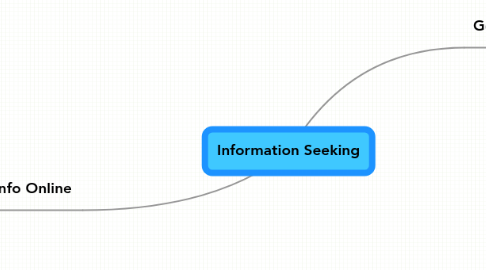
1. General Research
1.1. David Ellis
1.1.1. Starting
1.1.1.1. identifiying relevant sources
1.1.2. Chaining
1.1.2.1. following and connecting new needs
1.1.3. Browsing
1.1.3.1. scanning contents of identified sources for subject affinity
1.1.4. Differentiating
1.1.4.1. filtering and assessing sources for usefulness
1.1.5. Monitoring
1.1.5.1. keeping abreast of developments in a given subject area
1.1.6. Extracting
1.1.6.1. systematically working through a given source for material of interest
1.1.7. "A Behavioral Model for Information Retrieval System Design" Journal of Information Science, 1989
1.2. Choo & Turnbell
1.2.1. "Information Seeking on the Web: an integrated Model of Browsing and Searching"
1.2.2. http://firstmonday.org/htbin/cgiwrap/bin/ojs/index.php/fm/article/view/729/638
1.3. Marcia Bates
1.3.1. "Toward an integrated model of information seeking", The fourth internation conference on information needs, seeking and use (Lisbon 2002).
1.4. Alan Foster
1.4.1. "A non-linear model of information seeking behavior", Information Research 10 (2005).
1.4.2. http://informationr.net/ir/10-2/paper222.html
1.5. Dervin & Milan
1.5.1. "Information Needs and Uses", Annual Review of Information Science and Technology 21 (1986): 3-33
1.6. Brenda Dervin
1.6.1. "From the Mind's Eye of the User: The Sense-Making Qualitative and Quantitative Methodology". Quality Research in Information Management, Ed. Glazier and Powell. Engelwood, CO: Libraries Unlimited (1992).
1.7. Nicholas Belkin
1.7.1. "Anomalous States of Knowledge as the Basis for Information Retrieval", Canadian Journal of Information Science 5 (1980): 133-143.
1.8. Robert S. Taylor
1.8.1. "Value-added Process in Document Based Systems: Abstracting and Indexing Services". Information Services and Use 4 (1984): 127-146
1.8.2. "Information Values in Decision Contexts", Information Managemnt Review 1 (1985): 47-55.
1.9. Tom Wilson
1.9.1. "Models in Information Behaviour Research". http://informationr.net/tdw/publ/papers/1999JDoc.html
2. Seeking Info Online
2.1. Research
2.1.1. Marcia Bates
2.1.1.1. "The Design of Browsing and Berrypicking Techniques for the Online Search Interface". online Review 13 (1989): 407-424.
2.1.2. Pirolli & Card
2.1.2.1. "Informaion Foraging in Information Access Environments"
2.1.3. New node
2.2. General problematic
2.2.1. Since linking from one source to another is simple and immediate, ppl can cover lots of information quickly.
2.3. Lost in Hyperspace
2.3.1. Reasons
2.3.1.1. People digress and get distracted because of prevalence of other information sources. Ths phenomena os known as "embedded distraction".
2.3.1.2. Hypertext has no sense of location and physical presence/distance
2.3.2. Research
2.3.2.1. Jeff Conklin
2.3.2.1.1. "Hypertext: an Introduction and Survey" IEEE Computer 20 (1987): 17-41
2.3.2.2. Carolyn Foss
2.3.2.2.1. "Tools for reading and Browsing Hypertext", Information Processing and Management 25 (1989): 407-418
2.4. Browsing behaviour
2.4.1. People stay on pages only for a very short amount of time.
2.4.2. Research
2.4.2.1. Catledge & Pitkow: "Characterizing Browsing Strategies in the WWW".
2.4.2.1.1. http://www.igd.fhg.de/archive/1995_www95/papers/80/userpatterns/UserPatterns.Paper4.formatted.html
2.4.2.2. Cockburn & McKenzie: "What do web users do? An empirical analysis of web use". International Journal of Human-Computer Studies. http://www.cosc.canterbury.ac.nz/andrew.cockburn/papers/ijhcsAnalysis.pdf
2.4.2.3. Weinreich, Obendorf, Herder & Mayer: "Off the beaten tracks: exploring three aspects of web navigation" http://www2006.org/programme/files/xhtml/18/p018-weinreich/p018-weinreich.html
2.4.3. Navigating web sites
2.4.3.1. The core behaviour of navigation happens in a cycle of prediction, reorientation and habituation:
2.4.3.1.1. Habituation: While interacting with a web site, ppl become acustomed to its navigation mechanism and overall system. Experience with other sites is also carried over.
2.4.3.1.2. Prediction: From patterns of navigation within a web site and cues that provide scent of information, such as link labels and link position, people predict the atributes of destination pages. They anticipate what comes next while navigating.
2.4.3.1.3. Reorientation: Once a new page is reached, ppl familiarize themselves with it. Reorientation occurs. The navigation on the new page now becomes incorporated into the navigator's model of the site, and the cycle begins again.
2.4.3.1.4. David Danielson: "Transitional volatility in web navigation". http://www.stanford.edu/group/siqss/itandsociety/v01i03/v01i03a08.pdf
